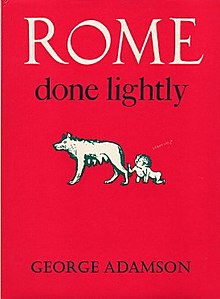Rome Done Lightly
 Jacket showing the Capitoline sculpture of Romulus and Remus and the she-wolf | |
| Author | George Adamson |
|---|---|
| Illustrator | George Adamson |
| Cover artist | George Adamson |
| Country | United Kingdom |
| Language | English |
Release number | 1st edition |
| Subject | Humour, Rome, Tourism |
| Published | London |
| Publisher | Chatto & Windus |
Publication date | 13 January 1972 |
| Media type | |
| Pages | 45 |
| ISBN | 978-0-7011-1622-4 |
| OCLC | 548618 |
| 914.56/32/0492 | |
| LC Class | DG806.2 .A63 |
| Website | www.georgewadamson.com |
Rome Done Lightly is George Adamson's 1972 "light-hearted romp"[1] in words and drawings through the Eternal City.
Summary[edit]
"Tongue in cheek, [Adamson] sets the reader on a trail of research — does the Church of San Demente really exist? Why was the Bridge of Four Heads so named?"[2] His text is full of curious and useful information, and some of the drawings were first published in Punch in two cartoon features on Rome.[3]
Critical reception[edit]
The Economist praised the artist's skill as a cartoonist: "Familiarity breeds caricature: it is difficult to cartoon the unfamiliar. Mr Adamson has managed beautifully, with the minimum of tedious explanation and the maximum of careful drawing . . ."[4] Cecil Roberts writing in Books and Bookmen touched upon a paradox underlying much of Adamson's work: "I wish [Rome] wasn't done so lightly. I am distressed to see so superb an artist put on cap and bells when illustrating the Roman scene."[5]
Notes[edit]
- ^ Chatto & Windus advertisement in The Times, 29 June 1972, p. 11, issue 58517.
- ^ From the book's jacket blurb.
- ^ 1. "The Roman Pace": 11 drawings: Fountains spurt; Flats proliferate; Ornament runs riot; Piazzas beckon; Conversation is visible; All roads lead; Steps climb; Romans can Hurry; Cats; Guides drone; And tourists pay (Punch, vol. 146, no. 6468, 26 August 1964, pp. 302–4); 2. Not Built in a Day: 4 Rome drawings (Punch, vol. 250, no. 6539, 5 January 1966, pp. 16–17).
- ^ The Economist, vol. 242, 29 January 1972, p. 63, issue 6701.
- ^ Cecil Roberts concluded with the remark: "I would like Mr Adamson to go again to Rome not so lightly, and reveal what a splendid artist he is, without the tongue in his cheek." Books and Bookmen, vol. 17, no. 6, issue no. 198, March 1972, p. 68. In his review Roberts alludes to the colossal statue of Moses standing above four lions spouting water shown in one of Adamson's drawings. He claims that Adamson's text is erroneous and that no such artist as Bresciano existed. Rather it is the work of Prospero da Brescia. See, however, "The Discourse of failure in seventeenth-century Rome: Prospero Bresciano's 'Moses'", Steven F. Ostrow, The Art Bulletin, Vol. 88, No. 2 (June, 2006), pp. 267–91.
